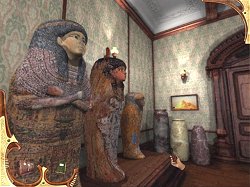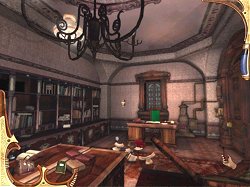|
Sherlock Holmes: The Mystery of the Mummy
 Lord Montcalfe, a renowned Egyptologist has disappeared and the police are convinced he has killed himself; after all he was acting strangely in the months leading up to his disappearance. His daughter, Elisabeth, however, has other ideas and she wants to learn the truth. Calling on a soon-to-be family connection (Elisabeth is to marry a cousin of Sherlock Holmes) she asks the famous detective to investigate. The introduction shows Holmes reading Elisabeth's letter on his way to Lord Montcalfe's manor. He is admitted by a servant and then left to his own devices to seek out the clues. The manor itself is a virtual museum of Egyptian artefacts and, because of Lord Montcalfe's paranoia in his last days, a potential death trap.
It seems that Lord Montcalfe was convinced he had triggered a mummy's curse so he had locked many of the rooms with cunning conundrums - some of them lethal. Was he protecting himself and his family or merely protecting his treasures? If so, from whom? One thing is certain, only someone of considerable resourcefulness and ingenuity is capable of solving the mystery and staying alive. Lord Montcalfe, a renowned Egyptologist has disappeared and the police are convinced he has killed himself; after all he was acting strangely in the months leading up to his disappearance. His daughter, Elisabeth, however, has other ideas and she wants to learn the truth. Calling on a soon-to-be family connection (Elisabeth is to marry a cousin of Sherlock Holmes) she asks the famous detective to investigate. The introduction shows Holmes reading Elisabeth's letter on his way to Lord Montcalfe's manor. He is admitted by a servant and then left to his own devices to seek out the clues. The manor itself is a virtual museum of Egyptian artefacts and, because of Lord Montcalfe's paranoia in his last days, a potential death trap.
It seems that Lord Montcalfe was convinced he had triggered a mummy's curse so he had locked many of the rooms with cunning conundrums - some of them lethal. Was he protecting himself and his family or merely protecting his treasures? If so, from whom? One thing is certain, only someone of considerable resourcefulness and ingenuity is capable of solving the mystery and staying alive.
 As this is a first person, solitary exploration game (occasionally interspersed with third person cut scenes) you will be playing as Holmes. Your progress through the story, however, is without the benefit of Doctor Watson's at times dubious insights and occasional unwittingly inspirational assistance. Watson does show up at the end just in time for the denouement, and just in time to provide an appreciative audience for Holmes' final display of brilliance, but he is sadly missed beforehand.
Really, the Holmes that we all know and love needs a constant audience to impress as he considers the evidence and makes his deductions. Either he needed to address the player more often in this game or a third person perspective engine may have allowed a greater role for Watson in the actual story to overcome this problem. Still, the manor is an intriguing and fascinating place to explore with secret passages and hidden panels, and enough locked doors and cryptic notes to keep you thinking - or guessing. As this is a first person, solitary exploration game (occasionally interspersed with third person cut scenes) you will be playing as Holmes. Your progress through the story, however, is without the benefit of Doctor Watson's at times dubious insights and occasional unwittingly inspirational assistance. Watson does show up at the end just in time for the denouement, and just in time to provide an appreciative audience for Holmes' final display of brilliance, but he is sadly missed beforehand.
Really, the Holmes that we all know and love needs a constant audience to impress as he considers the evidence and makes his deductions. Either he needed to address the player more often in this game or a third person perspective engine may have allowed a greater role for Watson in the actual story to overcome this problem. Still, the manor is an intriguing and fascinating place to explore with secret passages and hidden panels, and enough locked doors and cryptic notes to keep you thinking - or guessing.
The game starts off easily enough with a simple puzzle to whet your appetite but then becomes progressively more difficult as you explore newly opened locations and move the story along. Many of the puzzles involve finding and using inventory items and you will need to search the screens carefully as some things are very small or hidden in shadows and are barely distinguishable from the surrounding background. The cursor is a great help here, as it will change to a magnifying glass to give you a close up of an area of interest, or to a grasping hand when there's something to pick up. Occasionally it will also show a small spanner icon to indicate that you can operate something, when this icon appears in your inventory this means you can combine objects. Take care, though, there is at least one location where this 'operate' cursor won't show up until you have 'triggered' it by doing something in another room. However, you generally won't be doing too much back tracking as the game plays in episodes or levels so that as you move on only certain locations will be accessible for that level.
 You will also find many documents to read and some of these may provide vital clues or even be a more direct part of a puzzle such as a code you will need to decipher then input the solution into an in-game puzzle in a particular way. I was stuck here for a long time for even though I had deciphered the code I couldn't complete the puzzle. I had to get a hint but I am assured that the clues are there, I must have missed them. You will also find many documents to read and some of these may provide vital clues or even be a more direct part of a puzzle such as a code you will need to decipher then input the solution into an in-game puzzle in a particular way. I was stuck here for a long time for even though I had deciphered the code I couldn't complete the puzzle. I had to get a hint but I am assured that the clues are there, I must have missed them.
I should also point out that some actions are timed but these are, on the whole, reasonably forgiving in that there is usually ample time or you can find a way to extend it. Except for one that was annoying as it followed a cut sequence and a longish new level load before presenting you with about ten seconds to act. I died and restored several times before I hit on the simple answer. The problem is that unless you get lucky and spot the solution straight away there is hardly sufficient time to look around and consider the problem before you are dead.
The Curse of the Mummy also has one other very long timed sequence that occurs at the end when you must find the location of a device before it's too late. There are several things you need to do and one of them is working out a sizeable Japanese style picture puzzle (hmm a Japanese invention in a game with an Egyptian theme set in Victorian England). Unless you are an expert with this type of puzzle you will need a lot of time to solve it within the game. Alternatively, you can draw the grid pattern for yourself and work on it away from the computer, which will probably be the most satisfying way to tackle it. If in doubt you could visit Conceptis and complete a tutorial or download more practice puzzles if you happen to get hooked. I quite enjoyed fiddling with this puzzle, it's very absorbing but I definitely don't think it works in a timed sequence, even a very long one. Once again I have to make the point that although timed sequences might increase the dramatic tension for some, for others they are nothing more than an annoyance. If you fall into the latter category, take note!
The Mystery of the Mummy takes place entirely within the Montcalfe Manor and provides many interesting rooms to explore though I would have appreciated maybe one outdoor scene. The screens are very detailed, if a bit dark at times, and it is fun to re-explore many of the locations later in the game after they have been devastated by an earlier event. Almost all the character interaction takes place in cut scenes that, unfortunately, are not subtitled, though Holmes' comments throughout the game appear in a text box that pops up briefly. John Bell provides the voice of Holmes (and Watson) and does a pretty good job with the limited dialogue. In fact without Bell's portrayal as well as the odd cut scene and the pipe cursor it would be easy to forget that you are playing as Sherlock Holmes.
This mouse-controlled game ships on one CD and plays in full screen framed by a small but fancy interface overlay in the top right and bottom left hand corners. The bottom left overlay holds your inventory and notebook icons. The notebook opens to provide access to the game controls for saving and loading etc and is also where you will find the important documents that you pick up rather than in your inventory. These documents contain valuable clues so check here regularly. As I mentioned above, Holmes can die if you are careless or slow-witted so remember to save often, especially later in the game, though only six save slots are provided.
The game was originally subtitled The Curse of the Mummy before this was changed to Mystery of the Mummy and is scheduled to be released in several languages including French, English, Italian, Spanish and German. Frogwares is a small independent team so the game does have some slightly rough edges such as some translation problems and awkward phrasing in the English version and a cursor that occasionally fails to respond, but what it lacks in refinement it makes up for in its enthusiasm for its subject. It's a good length game with lots to do and think about and the puzzles are generally satisfying and befitting Holmes' powers of deduction.
Copyright © Gordon Aplin 2002.
All rights reserved.
System Requirements:
Minimum: IBM PC or 100% compatible, Pentium II-300 or higher, 64 MB RAM, 100% DirectX 8-compatible 8 MB Video Card, Windows-compatible sound card (100% DirectX 8-compatible), Quad-speed (4x) CD-ROM drive, 200 MB free disk space, 100% Windows-compatible mouse and keyboard.
Recommended: Pentium III-600 or higher, 128 MB RAM, 100% DirectX 8-compatible 16 MB 3D Accelerated Card, Windows-compatible sound card (100% DirectX 8-compatible) 32 speed (32x) CD-ROM drive or faster, 200 MB free disk space.
|

